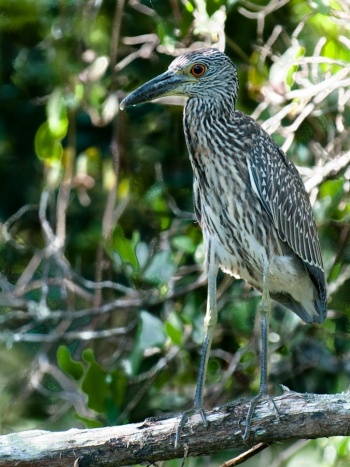(User template added to Photo, Video link & Category) |
Amurfalcon (talk | contribs) (Juvenile picture) |
||
| Line 4: | Line 4: | ||
==Identification== | ==Identification== | ||
61 cm. Grey body, white crown and back, red eyes and short yellow legs, white stripe below the eye. Juveniles resemble young [[Black-crowned Night-Heron]]s and [[American Bittern]], being mainly brown flecked with white or gray. | 61 cm. Grey body, white crown and back, red eyes and short yellow legs, white stripe below the eye. Juveniles resemble young [[Black-crowned Night-Heron]]s and [[American Bittern]], being mainly brown flecked with white or gray. | ||
| − | + | [[Image:Yellow Crowned Nighthern Immature.jpg|thumb|350px|right|Juvenile <br /> Photo by {{user|jonsund|jonsund}} <br /> Taken in Anastasia State Park, St. Augustine, [[Florida]]]] | |
==Distribution== | ==Distribution== | ||
North, Central and South America: breeds in eastern [[North America]] coastally from southern [[New England]] to [[Florida]] and the [[Gulf Coast]] and inland from the [[Great Lakes]] to [[Colorado]] and [[Texas]]. Range continues along Gulf Coast of [[Mexico]] and south to [[Panama]] and also occurs on the west coast from Baja California southwards. In [[South America]] occurs in coastal areas from [[Colombia]] to Rio Grande do Sul, Bazil in the east, south to northern [[Peru]] in the west and on the [[Galapagos Islands]]. Also occurs throughout the [[West Indies]] and has been reintroduced to [[Bermuda]]. | North, Central and South America: breeds in eastern [[North America]] coastally from southern [[New England]] to [[Florida]] and the [[Gulf Coast]] and inland from the [[Great Lakes]] to [[Colorado]] and [[Texas]]. Range continues along Gulf Coast of [[Mexico]] and south to [[Panama]] and also occurs on the west coast from Baja California southwards. In [[South America]] occurs in coastal areas from [[Colombia]] to Rio Grande do Sul, Bazil in the east, south to northern [[Peru]] in the west and on the [[Galapagos Islands]]. Also occurs throughout the [[West Indies]] and has been reintroduced to [[Bermuda]]. | ||
Revision as of 02:59, 12 September 2009

- Nyctanassa violacea
Identification
61 cm. Grey body, white crown and back, red eyes and short yellow legs, white stripe below the eye. Juveniles resemble young Black-crowned Night-Herons and American Bittern, being mainly brown flecked with white or gray.
Distribution
North, Central and South America: breeds in eastern North America coastally from southern New England to Florida and the Gulf Coast and inland from the Great Lakes to Colorado and Texas. Range continues along Gulf Coast of Mexico and south to Panama and also occurs on the west coast from Baja California southwards. In South America occurs in coastal areas from Colombia to Rio Grande do Sul, Bazil in the east, south to northern Peru in the west and on the Galapagos Islands. Also occurs throughout the West Indies and has been reintroduced to Bermuda. Most northern birds move southwards after breeding to winter in the southern USA, Mexico, Central America and the West Indies. Vagrants recorded north to Nova Scotia and Newfoundland.
Taxonomy
Six subspecies are recognised.
- North American and east Mexican birds belong to nominate race
- paler and larger-billed bancrofti occurs in western Baja California and the West Indies.
- gravirostris from Socorro is also large-billed and calignis of the Pacific coast from Panama to Peru has a large bill and darker grey upperparts.
- Remainder of South American range is occupied by cayennensis. Slender-billed with dark upperparts.
- pauper from the Galapagos Islands is small and dark.
Habitat
Mainly coastal areas including rocky shores, mudflats and mangroves. Also inland on lakeshores and riverbanks. Breeding in swamps and marshes.
Behaviour
They often nest in colonies; the nests are platforms of sticks in trees or shrubs overhanging water. 3–5 pale blue-green eggs are laid.
They hunt prey mainly at night and the diet includes crustaceans, molluscs, frogs, aquatic insects and small fish.
External Links




